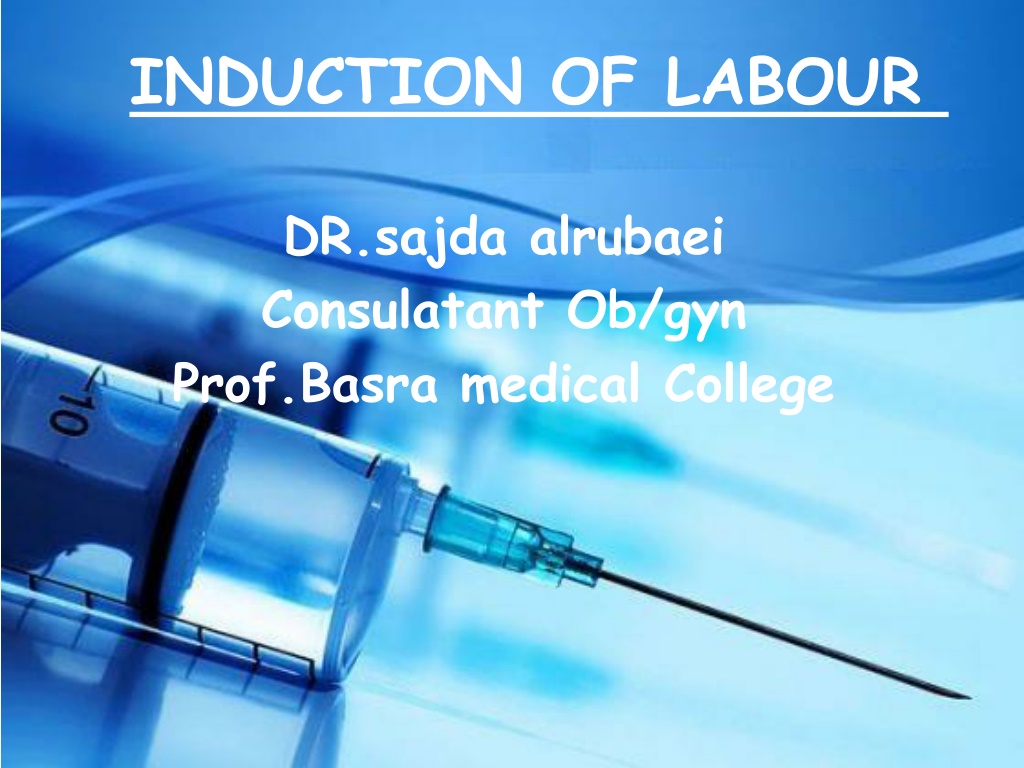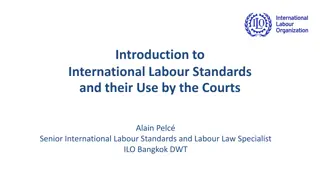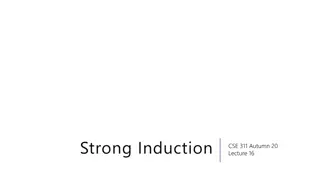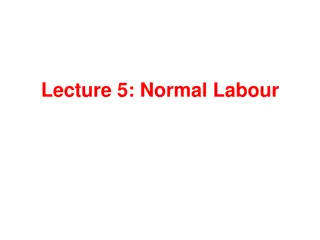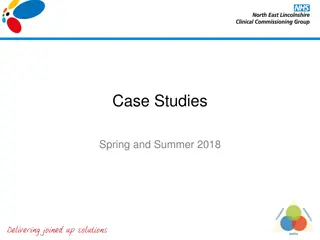Overview of Induction of Labour for Obstetric Practice
Induction of labor is the artificial initiation of the labor process before it begins naturally. This procedure is performed in cases such as premature rupture of membranes, prolonged pregnancy, preterm premature rupture of membranes, pre-eclampsia, and maternal medical conditions like diabetes or chronic renal disease. The article discusses the indications, contraindications, factors to assess prior to induction, and methods used for labor induction, including the modified Bishop's score. Additionally, it provides insights on the time, place, and preparation required for a successful induction of labor.
Download Presentation

Please find below an Image/Link to download the presentation.
The content on the website is provided AS IS for your information and personal use only. It may not be sold, licensed, or shared on other websites without obtaining consent from the author.If you encounter any issues during the download, it is possible that the publisher has removed the file from their server.
You are allowed to download the files provided on this website for personal or commercial use, subject to the condition that they are used lawfully. All files are the property of their respective owners.
The content on the website is provided AS IS for your information and personal use only. It may not be sold, licensed, or shared on other websites without obtaining consent from the author.
E N D
Presentation Transcript
INDUCTION OF LABOUR DR.sajda alrubaei Consulatant Ob/gyn Prof.Basra medical College
What is Induction of Labour? Induction of labor is the artificial initiation of labour mechanism prior to its spontaneous onset.
Time, place & preparation Time of induction: Preferably early morning Place of induction: where facility for intervention and fetal monitoring is available Preparation of Patient : Enema may be given to patients prior to induction
Indications of Induction of labor Premature rupture of membrane Prolonged pregnancy Preterm premature rupture of membrane Pre eclampsia, Eclampsia
Indications for induction of labor Maternal medical illness like 1. Diabetes(in Placental insufficiency, uncontrolled DM) 2. Chronic renal disease Rh-isoimmunisation Abruptio placenta Fetus with congenital anomaly Intra Uterine Death
Contraindications of induction of labor Contracted pelvis and CPD Malpresentations Previous classical caesarean section & hysterotomy Uteroplacental factors: unexplained vaginal bleeding,vasa previa,placenta previa Cord presentation,cord prolapse Active genital herpes infection,HIV Pelvic tumor
Factors to assess prior to induction Maternal To confirm the indication Exclude the contraindicatn Assess Bishop score Assess pelvic adequacy Fetal Ensure fetal gestnage Ensure fetal presentation Confirm fetal well being
Modified Bishops Score Favourable score->6 Best score-8
hygroscopic dilators, osmotic dilators (Laminaria japonicum), Foley catheters, double balloon devices, and extraamniotic saline infusion.
Membrane sweeping Its possible only if the cervix has ripened to allow the passage of one finger. Insertion of a gloved finger through the cervix and it s rotation against the wall of the uterus. Its strips off the chorionic membrane from the underlying decidua releases PGS Placenta previa should be excluded, Accidental amniotomy is a disadvantage.
Amniotomy AROM stretching of the cervix & separation of the membranes release of Prostaglandins Depends on the state of the cervix and station of the presenting part ADV:High success rate and chance to see the amniotic fluid DIS: cannot be applied in an unfavourable cervix, possibility of cord prolapse
BALLOON CATHETERS The Atad Ripener Device in place with the two balloons inflated. The uterine balloon is at the internal os and the cervicovaginal balloon is at the external os.
Amniotomy CONTRAINDICATIONS: 1.IUD 2.HIV HAZARDS: 1.Cord prolapse 2.Amnionitis 3.Amniotic fluid embolism 4. Abruptio placentae
Prostaglandins Chemistry:PG is a carboxylic acid synthetised from arachidonic acid. Source: menstrual fluid, endometrium, decidua and amniotic membrane TYPES PGE1 -amnion PGE2-amnion PGF2-decidua and myometrium PGI2-myometrium
Mechanism of action It causes change in the myometrial cell memb permeablity and alteration in the membrane bound calcium It also sensitises the mometrium to the oxytocin PGE2 has its collagenolytic activity alter the ground substance of cervix cx ripening
Prostaglandins PGE2 PGE1 Dinoprostone (Cerviprime) Misoprostol
How to give Misoprostol? Dose of 25 micro gram every 4hrly to a maximum of 6 doses can be given intravaginally Dose of 50micro gram every 3hrs to a maximum of 6 doses can be given orally Dose of 25micro gram every 2hrs can be given orally Other routes of administration: 1.Buccal 2.rectal 3.sublingual
Oral Vs vaginal Misoprostol ORAL VAGINAL Less effective when compared to vaginal PG More effective when compared to oral route Chance of fetal distress is less Chance of fetal distress is more
Dinoprostone Vaginal gel 0.5mg can be given intracervically. It can be repeated after 6 hrs for 3 4 doses if required Vaginal tab 3 mg can be given in the posterior fornix followed by 3mg after 6-8 hrs to a maximum dose of 6mg Vaginal pessary releasing dinoprostone 10mg over 24hrs.It is removed when cx ripening is adequate
Misoprostol Vs Dinoprostone Cheap & cost effective Stable at room temp Easy to administer Costly Need refrigeration
Contraindications of PGs Bronchial asthma Pulmonary disease Previous uterine scar is relatively contraindicated
Oxytocin It s a nanopeptide synthetised in the supra optic and paraventricular nuclei of the hypothalamus. Half life of 3-4 mins and duration of action 20 mins Oxytocin is used very commonly to achieve induction of labour. The objective is to produce uterine contractions that effectively produce cervical change and descent of the presenting part.
Mode of Action 1.It acts throgh the receptor and voltage gated calcium channel myometrial contraction 2.It stimulates amniotic and decidual PG production Preparations Available in ampoules containing 5IU/ml Buccal tab containing 50IU/ml Nasal solution containing 40units/ml Routes of administration: 1.I.V infusion Intra muscular Buccal tablets Nasal spray
Oxytocin (syntocinon) should be used with extreme caution in multiparous women. Oxytocin (syntocinon) should not be started for six hours following administration of vaginal prostaglandins If a trial of labour is judged safe then Oxytocin may be used. Oxytocin should be used with caution with a previous uterine scar. F A C T S Oxytocin should always be used in conjunction with the partogram once in established labour.
Advantages Cheaper and effective Easy titrable Disadv: .Needs refrigeration .Effectiveness less with: 1. less Bishop score 2.IUD 3.lesser weeks of pregnancy
Hazards of oxytocin Uterine hyperstimulation: (Normal:3 contractions in 10 mins each lasting for 45secs) (>5 contractions in 10mins each lasting for 1min) Water intoxication:It due to anti diuretic action(30- 40IU/ml).Manifested by hyponatremia,confusion,coma and CCF Fetal distress Uterine rupture Hypotension
Failed Induction Of Labor If Amniotomy is still impossible after a maximum no. of doses of Prostaglandins have been given or If the cervix remains uneffaced and <3cm dilated after an Amniotomy has been performed & Oxytocin has been running for 6-8hrs with regular contractions Possible Causes 1. Placental Sulfatase deficiency 2. Lack of Essential Cytokines
Complications of IOL Uterine Hyperstimulation Uterine rupture Maternal Upset Iatrogenic Fetal Prematurity Fetal Distress Failed induction
CONCLUSION during Induction of Labor, B B enefits should be weighed, R R isks should be assessed, A A lternatives should be considered, N N ecessity of intervention adjudged & D D ecision should be taken accordingly BUT, INJUDICIOUS USE of Labor Inducing agents should be avoided
THANK YOU THANK YOU
